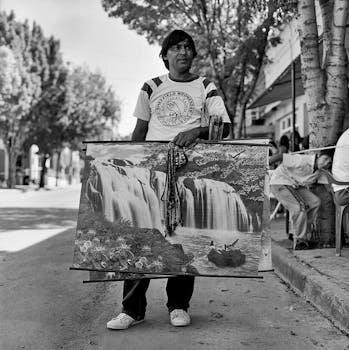rosario de los 7 dolores pdf
- Published
- in PDF
What is the Rosario de los 7 Dolores?
The Rosario de los 7 Dolores, or Rosary of the Seven Sorrows, is a devotion honoring the Virgin Mary’s suffering during Jesus’s passion and death. It’s a prayer for strength and repentance.
Origin and History of the Devotion
The devotion to the Seven Sorrows of Mary has roots tracing back to the 13th century. It gained prominence through revelations to Saint Bridget of Sweden, who was told of seven graces granted to those honoring Mary’s tears and sorrows. The rosary format, with specific meditations and prayers, developed over time. Some accounts link the rosary to a visionary, Marie Claire, to whom Our Lady gave the prayers and meditations. The devotion emphasizes meditating upon Mary’s profound suffering alongside Jesus, fostering compassion and a deeper understanding of Christ’s sacrifice. This ancient prayer is seeing a revival as requested by Our Lady of Kibeho.
Significance of the Seven Sorrows
The Seven Sorrows represent key moments of pain and grief experienced by Mary, offering a powerful lens through which to contemplate the depth of Christ’s sacrifice and Mary’s unwavering faith. Meditating on these sorrows allows believers to connect with Mary’s compassion and find solace in their own suffering. The devotion provides a pathway to repentance and conversion, as highlighted by Our Lady of Kibeho. By honoring Mary’s sorrows, individuals seek to gain strength, peace, and a deeper understanding of divine mysteries. The rosary serves as a reminder of love, sacrifice, and the promise of consolation in times of affliction.

How to Pray the Rosario de los 7 Dolores
Praying the Rosario involves meditating on each of Mary’s sorrows while reciting specific prayers. This practice offers solace, strength, and a deeper connection to Mary’s suffering and faith.
Structure and Prayers
The Rosario de los 7 Dolores follows a distinct structure. It begins with an Act of Contrition, expressing sorrow for sins and seeking God’s mercy. Then, for each of the seven sorrows, one Our Father (Padre Nuestro) is recited, followed by seven Hail Marys (Ave Marías). These prayers accompany meditation on the specific sorrow.
After each set of prayers, a Gloria is said. The Fatima prayer can also be included⁚ “Mother, let my heart accompany your sorrow in the death of Jesus”. The Hallow App provides guidance. This structured prayer, rooted in the 13th century, seeks strength for repentance.
Meditations on Each Sorrow
Praying the Rosario de los 7 Dolores involves meditating on each sorrow of Mary. These meditations are crucial for understanding the depth of Mary’s suffering and her profound love for Jesus. Each sorrow offers an opportunity to reflect on the pain and sacrifice endured by both Mary and Jesus during his Passion.
Marie Claire, a visionary, received meditations for each sorrow from the Mother of the Word. By contemplating these sorrows, devotees seek strength to repent and convert their hearts. Meditating allows one to connect with the sorrow and find solace in Mary’s example.

The Seven Sorrows of Mary
The Seven Sorrows of Mary are key moments of pain and grief she experienced alongside Jesus. These sorrows highlight her deep connection to His sacrifice and suffering.
1st Sorrow⁚ The Prophecy of Simeon
The first sorrow recalls when Mary and Joseph presented Jesus in the Temple. Simeon, a righteous man, recognized Jesus as the Messiah but prophesied to Mary that a sword of sorrow would pierce her heart.
This prophecy foreshadowed the immense suffering she would endure as she witnessed her Son’s Passion. It marked the beginning of her journey of sorrow, linking her intimately with Jesus’s redemptive mission. The pain foretold by Simeon highlights Mary’s unique role in salvation history and her unwavering faith in God’s plan, even amidst future suffering. This is a cause for reflection.
2nd Sorrow⁚ The Flight into Egypt
The second sorrow reflects on Mary and Joseph’s flight into Egypt with the infant Jesus to escape Herod’s decree to kill all male children. This involved immense hardship and uncertainty, as they became refugees in a foreign land.
This sorrow highlights the challenges and difficulties faced by the Holy Family, emphasizing their vulnerability and reliance on God’s providence. Leaving their home and community, they endured a long and perilous journey to protect Jesus. It reminds us of the sacrifices families make to protect their loved ones and the importance of compassion for those who are displaced and persecuted.
3rd Sorrow⁚ The Loss of Jesus in the Temple
The third sorrow meditates on Mary and Joseph’s distress when they lost young Jesus in Jerusalem and searched for Him for three days. Their anxiety and worry underscore the deep bond between parent and child and the pain of separation.
This sorrow highlights the mystery of Jesus’s divine nature and His growing awareness of His mission. When they found Him in the Temple, teaching the elders, He reminded them that He had to be in His Father’s house. It teaches us about obedience to God’s will, even when it is difficult to understand, and the importance of seeking Jesus in our lives.
4th Sorrow⁚ Mary Meets Jesus Carrying the Cross
The fourth sorrow recalls the agonizing encounter between Mary and Jesus as He carried His cross to Calvary. Imagine the immense pain Mary felt, witnessing her beloved Son, burdened, beaten, and humiliated. This sorrow highlights Mary’s unwavering love and compassion for Jesus.
She endures this painful moment, sharing in His suffering. This sorrow teaches us about empathy and the importance of standing by those who are suffering. It reminds us to offer support and comfort to those who carry their own crosses in life. Mary’s example encourages us to be present and compassionate in the face of others’ pain.
5th Sorrow⁚ The Crucifixion of Jesus
The fifth sorrow meditates on the crucifixion of Jesus. Picture Mary standing at the foot of the cross, witnessing her Son’s agonizing death. This is the peak of her suffering, the ultimate sacrifice for humanity’s redemption.
Mary’s unwavering faith and love remain steadfast even in this moment of profound sorrow. This sorrow reminds us of the immense love and sacrifice of Jesus for our salvation. It calls us to reflect on the depth of His suffering and to appreciate the gift of redemption He offers. We are reminded of Mary’s courage in the face of unbearable pain.
6th Sorrow⁚ Mary Receives the Body of Jesus
This sorrow contemplates the moment when Mary receives Jesus’s lifeless body after His crucifixion. Imagine the weight of His broken body in her arms, the unimaginable grief of a mother holding her dead son.
This sorrow highlights Mary’s profound love and compassion. She embraces her Son, offering a final act of maternal tenderness. This image evokes feelings of empathy and sorrow for Mary’s pain. It signifies her unwavering devotion and acceptance of God’s will, even in the face of immense loss. We reflect on the profound sacrifice made for humanity.
7th Sorrow⁚ The Burial of Jesus
The seventh sorrow focuses on the burial of Jesus. Consider the finality of placing His body in the tomb. This sorrow embodies the pain of separation and the apparent end of Jesus’s earthly life.
Reflect upon Mary’s grief as she witnesses her Son being laid to rest. Despite the immense sadness, there’s a glimmer of hope. This moment signifies not only loss but also anticipation of the Resurrection. Mary’s faith remains unwavering, trusting in God’s plan even amidst despair. The burial represents the ultimate sacrifice and the promise of eternal life.

Promises and Graces Associated with the Rosario
The Rosario de los 7 Dolores holds profound promises for those who devoutly pray it. Tradition states that those who honor Our Lady by meditating on her tears and sorrows will receive special graces. These include peace within families, illumination regarding divine mysteries, and consolation during times of sorrow. The Virgin Mary also promises to accompany devotees in their afflictions.
Moreover, this rosary is believed to grant strength for repentance and conversion. Praying with sincere meditation can lead to a deeper understanding of suffering and a closer relationship with Jesus and Mary. It fosters spiritual growth, offering solace and hope to those who seek it.

When to Pray the Rosario de los 7 Dolores
The Rosario de los 7 Dolores is particularly appropriate to pray during specific times of the year, especially when reflecting on the sorrows of Mary. The Feast of Our Lady of Sorrows, commemorated on September 15th, is a dedicated occasion to engage in this devotion, honoring Mary’s profound suffering and love during Jesus’s sacrifice.
Moreover, the Lenten season, with its focus on repentance and reflection on Christ’s Passion, offers a meaningful period for praying this rosary. Holy Week, leading up to Easter, provides an especially poignant time to meditate on the Seven Sorrows. However, the rosary can be prayed anytime, offering solace and strength throughout the year.
